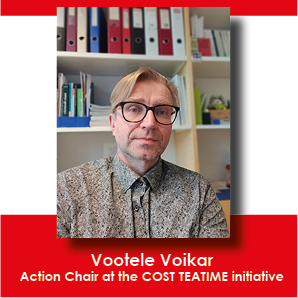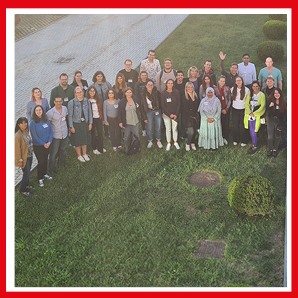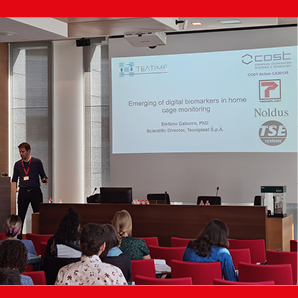
The current version of the Tecniplast website doesn't match your region. Please visit your local website to find information and offerings specific to your country.

The current version of the Tecniplast website doesn't match your region. Please visit your local website to find information and offerings specific to your country.

 Vootele Voikar was one of the moderators during the last DVC® Forum and, as Action Chair at the COST TEATIME initiative, he shares with us his opinion about these important events in the Tecniplast Headquarters.
Vootele Voikar was one of the moderators during the last DVC® Forum and, as Action Chair at the COST TEATIME initiative, he shares with us his opinion about these important events in the Tecniplast Headquarters.
Dear Vootele, we know that you recently presented at the Digital Vivarium Forum 2, an event held in Tecniplast on the last 6th of September 2022. Could you kindly share your opinion and feedback about this event?
First, I would like to congratulate Tecniplast for organizing such a great meeting and thank the organizers for inviting me to give a talk there.
I was very much disappointed by the fact that I could not attend in person (due to sudden illness), however, the last- minute decision to make the event as a hybrid turned out to be an excellent choice. The virtual platform worked perfectly and I am sure, people online enjoyed the scientific content as much as those present in the lecture hall. Of course, we were missing some personal touch and discussions during the coffee breaks and social gatherings. I was happy to attend the first Digital Vivarium Forum in 2019. The friendly atmosphere and lively discussions about future perspectives in using laboratory animals in biomedical research during that meeting made me eagerly wait for the next events. It had to be a longer wait due to the pandemic, but the outcome of DVF2 was great. In addition to presentations of research done with DVC® technology, I appreciated the openness of the symposium to other technology providers. I think it shows that in the end, “sharing is caring” and the competition in the field should be indeed seen as a collaborative effort towards better tools in animal research. We all have agreed that holistic view on animal behavior can improve many aspects of working with disease models (better monitoring of diseases symptoms, treatment effects, humane endpoints etc.). However, there is no system available which would capture equally well everything in animal behavior and physiology. Thus, there is a lot of room for improvement, but also admittance that research questions dictate the systems to be used, and there may be a niche for different manufacturers in providing best solutions for neuroscience, laboratory animal science, cardiovascular or metabolic research etc. However, every discipline would greatly benefit by knowing their animal models better, and 24/7 monitoring has a potential to enable it.
 Overall, DVF2 was a fantastic event to get updated on these efforts, and to meet people who care and together develop the future of animal research.
Overall, DVF2 was a fantastic event to get updated on these efforts, and to meet people who care and together develop the future of animal research.
We know you have a position as Action Chair at the COST TEATIME initiative. Could you kindly tell us more about this initiative and what you are targeting?
COST (European Cooperation in Science and Technology) is a funding organisation for research and innovation networks. At the the beginning of 2020, I initiated a discussion group between some researchers and core facility managers in Europe, working on behavioural phenotyping of mouse models. The idea was to have a forum for open discussion on problems and pitfalls in this field and sharing the best practice – very much inspired by ongoing concerns about reproducibility in biomedical research. This group was warmly welcomed by many, and then we started to think about sustainability and common goals. One of us, Sabine Hölter, pointed out that there is an open call for COST Actions, and we started to work on should be proposals for creating such a pan-European network of researchers and other stakeholders interested in improving biomedical research with animal models. It was not difficult to find the topic for this network – Home Cage Monitoring (HCM)! The proposal was submitted in November 2020, we received a positive decision on funding in May 2021, and kicked off the project in October 2021. By now, this network comprises over 120 researchers from 34 European countries.
To get familiar with the COST Action 20135 “Improving biomedical research by automated behaviour monitoring in the animal home-cage (TEATIME)” I recommend you visit our website, https://cost-teatime.org/. However, in a nutshell, the aim is to bring together the stakeholders using and developing automated home-cage monitoring technologies, and critically and transparently assess the potential of these technologies. We are conducting the survey to gather views to inform future developments and challenges in systems which monitor animals in home cage environments; we are conducting a systematic review on the current status and use of HCM; we are working on understanding the needs and providing the potential solutions related to data analysis, as this is obviously one of the hurdles in using these systems. These objectives fall into the category of generating new knowledge. However, a very important part of the Action is sharing the knowledge and generating output. To this end, the Action provides a grant system for young researchers to attend international meetings and present their work related to HCM. In addition, grants will be available for short-term scientific missions where researchers can visit another laboratory in a member country in order to carry out a short experiment or learn new techniques. I have to stress that COST Actions are strictly monitoring the policy of excellence and inclusiveness. These are bottom-up networks and the Actions will take into account the three main tenets of excellence and inclusiveness policy – geographical diversity (include researchers from the full European Research Area), promoting and including young researchers and innovators (age < 40 years), and gender balance. The networking nature of Action is further stressed by strong emphasis on communication and dissemination of our activities and scientific output. We have created accounts for COST_TEATIME in Twitter, LinkedIn and YouTube. In our YouTube channel, everyone interested can watch the recordings of TEATIME webinars where researchers share their experience in using a variety of novel approaches to monitor animal behavior.
 Recently, there was a COST TEATIME training school week, again held in Tecniplast, where young PhD students discovered more about the importance of Home Cage Monitoring. This is really a fast-growing community, could you share some feedback about this training week?
Recently, there was a COST TEATIME training school week, again held in Tecniplast, where young PhD students discovered more about the importance of Home Cage Monitoring. This is really a fast-growing community, could you share some feedback about this training week?
Our first introductory training school was a great success, indeed! We received 55 applications, which were evaluated by our selection committee and, based on the motivation and excellence, 24 students from 14 countries were selected to attend the school. As confirmed by the faculty, this selection was really excellent – open-minded students, challenging with their active engagement also the faculty. This was also highlighted by the students. In the course evaluation, most of them agreed that the course was of high quality, structure and organization was very good, and very importantly in my opinion – the course promoted interaction between the participants at all levels. From personal experience (both as a student or teacher) I can confirm that in addition to new knowledge gained in such training events, the new contacts, discussions and informal sharing of one’s experience are the most valuable outcome! Excellent location and professional support by Tecniplast in all practicalities certainly contributed positively to the success of the course! There were many people involved in faculty and local teams – I want to thank them all! I will finish this answer with the words of one student – Keep an eye on our website, or sign up to news, in order not to miss the next events!
Can you comment on the DVC technology and tell us your vision of DVC in the lab animal industry in the short term?
I do not yet have personal experience with DVC® technology, all I know is learned from presentations and personal communications. However, I see a great potential there. As mentioned, there is no better all-in-one solution available to monitor everything we are interested in the life of a laboratory rodent – activity, sleep, food and water intake, social interactions, metabolism, cognitive functions and emotionality. Moreover, the requirements differ for different purposes. In addition to research questions, the routine husbandry and welfare monitoring may require different approaches. However, as the majority of rodents in European animal facilities live in the caging systems provided by Tecniplast, I would say that not knowing anything about what happens with the animal during the time they spend in their home cage is really a waste, if the technology is available that could inform us at least of some features. Therefore, the DVC® has in my view a clear niche in collecting data from real, unmodified, scalable home cages and I know that the company is making huge efforts in maximizing the amount and quality of these data.
STEFANO GABURRO
SCIENTIFIC DIRECTOR TECNIPLAST S.P.A.